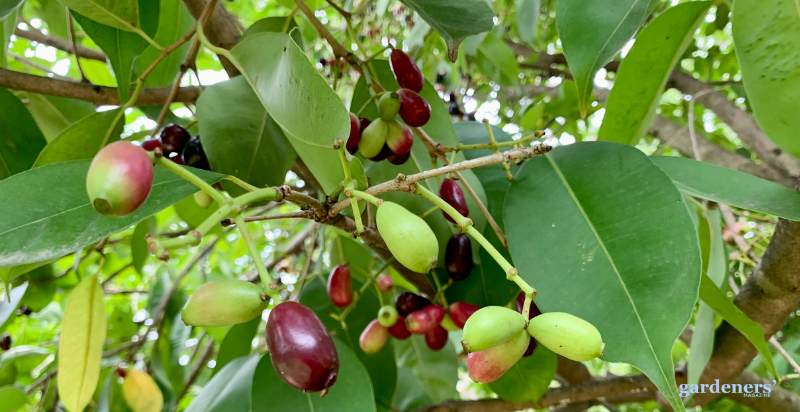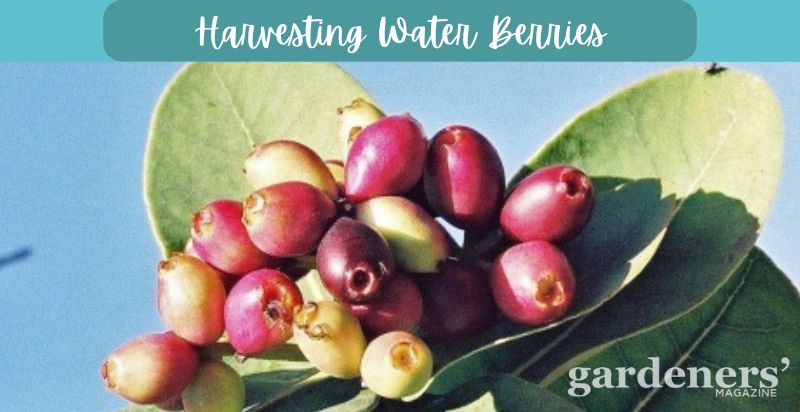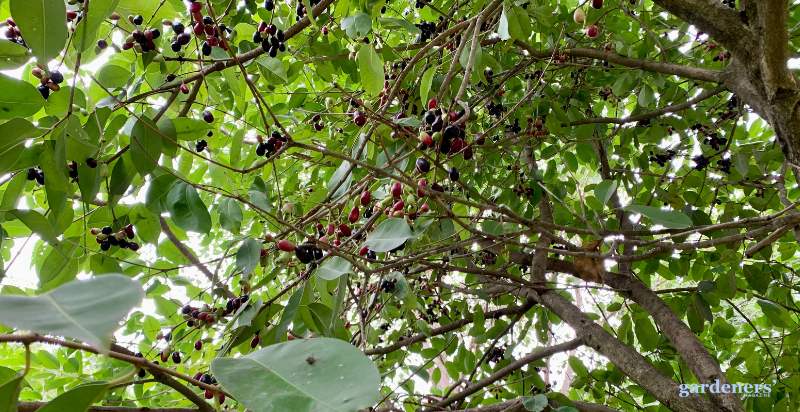If you’re curious about a delightful addition to your garden that’s both ornamental and fruitful, let me introduce you to the water berry, scientifically known as Syzygium cordatum. These charming trees are a favorite among garden enthusiasts not only for their lush, glossy leaves but also for their clusters of aromatic, water-rich berries that add a burst of flavor and color.
Native to the riverbanks and wetlands of Africa, water berries thrive in moist, well-drained soils, making them a perfect choice for waterside planting. Their berries, which turn from a deep pink to a rich, dark purple as they ripen, are not only a treat for the eyes but are edible and loved by both humans and wildlife.
So, if you’re looking to attract some birds and butterflies while enjoying a bit of foraging yourself, the water berry tree could be just the plant your garden needs.

What are Water Berries?
Water berries, scientifically known as Syzygium cordatum, are a type of fruit produced by a tree native to southern Africa. These trees belong to the Myrtaceae family, which includes various species of flowering plants known for their aromatic leaves and fruits. The water berry tree is especially valued for its environmental and economic benefits.
The tree itself can grow quite large and is often found along riverbanks and in wetlands, where it plays a crucial role in stabilizing the soil and providing habitat for wildlife. The berries are small, round, and typically a deep, dark purple when ripe. They are juicy and have a sweet, slightly tart flavor, making them popular for both culinary and traditional medicinal uses.
Water berries can be eaten fresh or used in various dishes. They are often incorporated into jams, jellies, and sauces and have also traditionally been used in local medicines to treat ailments like diarrhea and stomach upsets. The tree is also noted for its attractive appearance, with dense foliage and a canopy that provides ample shade, making it a favorite in landscape gardening and public parks.
History and Origin of Water Berries:
Water berries are native to the southern regions of Africa, thriving in moist areas such as riverbanks and wetlands. This species belongs to the broad Myrtaceae family and is known for its fragrant foliage and variety of trees and shrubs.
For generations, these trees have been an integral part of local traditions in their native lands. They are valued both for their fruit, which is eaten fresh and used in local dishes, and for their medicinal benefits. Traditionally, water berries have been used to treat a range of health issues, including respiratory and gastrointestinal problems. The tree’s wood is also prized for its strength and durability, which are useful in construction and craftwork.
Ecologically, the water berry tree is vital. It plays a crucial role in stabilizing the environment where it grows, preventing soil erosion along water bodies, and providing food and shelter for various wildlife species. The tree’s nectar-rich flowers attract birds and insects, while its dense canopy offers shade and adds to the landscape’s beauty.
Although primarily found in Africa, where specific climatic conditions prevail, in suitable environments elsewhere, these trees are occasionally cultivated for ornamental purposes in gardens and parks, celebrating their beauty and shade-giving qualities.
This enduring significance of the water berry tree emphasizes not only its utility as a resource but also its role in cultural heritage and ecological preservation within its native range.
Description of Water Berries:
These are small, rounded fruits that typically display a vibrant, deep purple hue when ripe. These berries are known for their juicy and succulent texture. The flavor of water berries is pleasantly sweet with a slightly tart undertone, making them both refreshing and enjoyable to eat fresh.
The skin of the water berry is smooth and thin, encasing a fleshy interior that houses small seeds. Due to their appealing taste and texture, these berries are often used in various culinary applications. They can be made into jams, jellies, and sauces, or simply enjoyed as a fresh snack. In addition to their uses in the kitchen, water berries are also noted for their nutritional benefits, including a good content of vitamins and antioxidants, which contribute to their health-promoting properties.
The attractive appearance and delightful taste of water berries make them a favored choice for both wildlife and humans. They also play an important role in the diets of various bird species in their native habitat.

Flavor Profile of Water Berries:
Water berries offer a distinctive flavor profile that appeals to many palates. These berries are known for their juicy and moist texture, which complements their taste well. They are predominantly sweet with a pleasantly tart undertone, creating a balanced and refreshing flavor. This combination makes them enjoyable both as fresh fruit and in various culinary creations.
The sweetness of water berries makes them a popular choice for making jams, jellies, and desserts, where their natural sugars can be highlighted. The subtle tartness adds a depth of flavor that enhances their versatility in recipes, allowing them to be paired effectively with both sweet and savory dishes.
Overall, the flavor profile of water berries is characterized by a delightful sweetness accented by a hint of tartness, making them a unique and favored fruit in regions where they are grown and consumed.
Seasonality and Availability throughout the Year of Water Berries:
Water berries typically exhibit a distinct seasonality, closely linked to the climatic conditions of their native habitats in southern Africa. These berries generally thrive in regions with wet conditions, which influences their growing and fruiting cycles.
The fruiting season of water berries mainly occurs during the warmer months, which in southern Africa corresponds to late spring through summer. This period usually spans from October to March, with peak availability around December to February. During this time, the trees produce abundant fruit, making the berries widely available in regions where they are native.
Outside of these peak months, water berries can be less commonly found, as their production decreases with the onset of cooler and drier weather. This seasonal pattern affects their availability in local markets and may influence their use in traditional and culinary practices during the off-peak season.
Health Benefits of Water Berries:
Water berries are not only tasty but also packed with various health benefits, making them a valuable addition to a healthy diet. Here’s an overview of the key health benefits they offer:
- Rich in Antioxidants: Water berries are high in antioxidants, which help neutralize harmful free radicals in the body. This can reduce oxidative stress and may lower the risk of chronic diseases such as heart disease and certain cancers.
- Nutrient-Dense: These berries contain a good range of vitamins and minerals, including vitamin C, which is crucial for immune system function, skin health, and wound healing.
- Anti-inflammatory Properties: The compounds found in water berries have anti-inflammatory effects, which can help reduce inflammation in the body, potentially easing conditions like arthritis and other inflammatory diseases.
- Digestive Health: Water berries have traditionally been used to treat digestive issues. Their fiber content and beneficial compounds may help relieve symptoms of diarrhea and other gastrointestinal disorders.
- Cardiovascular Health: The antioxidants and other heart-healthy compounds in water berries may contribute to cardiovascular health by improving blood circulation and reducing blood pressure.
- Antimicrobial Effects: Some studies suggest that extracts from the water berry tree can have antimicrobial properties, making them potentially useful in fighting certain bacterial and fungal infections.
These health benefits make water berries a great choice for those looking to enhance their diet with nutritious and functional foods. Incorporating water berries into your diet can be a delicious way to boost overall health.
Cultivation of the Water Berries:
Cultivating water berries involves several key practices to ensure healthy growth and fruitful harvests. Here’s a guide to the basic steps and conditions needed for successful cultivation:
- Climate and Soil Requirements: Water berry trees thrive in subtropical to tropical climates and are ideally suited to areas with high rainfall and humidity. They prefer moist, well-drained soils that are rich in organic matter or compost. They are not tolerant of drought and require regular watering if not planted near a natural water source.
- Planting: Water berries can be propagated from seeds or cuttings. The seeds need to be fresh to ensure good germination rates and should be planted in a seed-raising mix. Cuttings should be taken from young, healthy branches and rooted in a moist medium.
- Sunlight: These trees prefer full sun to partial shade. While they can tolerate shade, more sunlight encourages better fruit production.
- Watering: Consistent moisture is crucial, especially in the tree’s formative years. Once established, they can tolerate short periods of dryness, but prolonged drought can be detrimental.
- Fertilizing: Apply a balanced, slow-release fertilizer during the growing season to support healthy growth and fruiting. Additional compost or manure can help improve soil fertility and structure.
- Pruning: Regular pruning helps maintain the shape of the tree, remove dead or diseased wood, and encourage more fruitful branches. It’s best done after the fruiting season.
- Pest and Disease Management: Watch for common pests like aphids and scale insects. Fungal diseases can also be a concern, especially in humid conditions. Using eco-friendly pesticides and ensuring good air circulation can help manage these issues.

By following these cultivation tips, gardeners can successfully grow water berry trees and enjoy their fruits for many years. These trees not only provide delicious berries but also add aesthetic value to gardens with their lush foliage and attractive form.
Harvesting of the Water Berries:
Here’s a guide to effectively harvesting these berries:
- Timing: Water berries typically ripen during the warmer months, which in their native southern Africa is from late spring to summer. The berries are ready to harvest when they turn from pink to a deep, dark purple. It’s important to monitor the berries frequently as they approach maturity because they can quickly become overripe.
- Method: To harvest water berries, gently twist and pull the ripe berries from their stems or use gardening shears to snip them off. This helps prevent damage to the delicate branches of the tree.
- Handling: After harvesting, handle the berries gently to avoid bruising them. Water berries are quite juicy and can be damaged easily, which might affect their shelf life and aesthetic appeal.
- Storage: If not used immediately, water berries should be stored in a cool, dry place. They can be kept in the refrigerator to extend their freshness. For longer storage, water berries can be frozen or processed into jams and preserves.
- Usage: Freshly harvested water berries are versatile and can be used in various culinary preparations. They are excellent in desserts, jams, and sauces, or simply eaten fresh.

Proper harvesting and handling are key to enjoying the full flavor and benefits of water berries, while also maintaining the health of the tree for future seasons.
Where Do Water Berries Grow?
Water berries are native to southern Africa and are typically found in environments that are rich in moisture. These trees flourish along riverbanks, in swampy areas, and around other bodies of water. The regions they inhabit include several southern African countries like South Africa, Mozambique, Zimbabwe, and Zambia.
These trees thrive in subtropical and tropical climates where they can receive ample water. They prefer well-drained soils and can often be seen in riverine forests and floodplains. Beyond their native habitat, these trees have also been cultivated in other parts of the world with similar climatic conditions, such as other tropical and subtropical regions where they can be managed in botanical gardens and specialized horticultural landscapes.
In the United States, they may be cultivated in botanical gardens or by enthusiasts with similar subtropical to tropical climates that can mimic their natural growing conditions. Such areas would likely include parts of Florida, southern California, and possibly some regions of the Gulf Coast where temperatures remain mild throughout the year and sufficient humidity and moisture can be maintained.

What are the things to remember when buying Water Berries?
When buying water berries, there are several factors to consider to ensure you’re getting the best quality fruit. Here are some key points to keep in mind:
- Freshness: Look for berries that appear fresh and vibrant. The skin should be smooth and free from bruises or blemishes. The color should be a deep, dark purple, indicating ripeness.
- Firmness: Water berries should be firm to the touch but not hard. Overly soft berries may be past their prime and could be overripe or beginning to spoil.
- Uniformity: Check that the berries are uniform in size and color. This can be an indicator of proper harvesting and handling practices.
- Storage: Ask the seller about how the berries have been stored. Proper storage is crucial to maintain freshness. Berries should be kept cool and dry to prevent spoilage.
- Organic Certification: If you prefer organic produce, look for berries that are certified organic. This ensures that the berries have been grown without synthetic pesticides or fertilizers.
- Seasonality: Being aware of the seasonality of water berries can help ensure you’re buying them at their peak availability and taste. They are typically in season during the late spring to summer months in their native regions.
- Taste: If possible, try a berry to assess its taste. Water berries should have a sweet flavor with a hint of tartness.
By keeping these factors in mind, you can select high-quality water berries that are delicious and ripe for consumption.

What is the Best Way to Store Water Berries?
To store water berries, first, sort through them to remove any damaged ones. Place the fresh berries in a clean, dry container, seal it tightly, and refrigerate. Avoid storing them in a damp environment and refrain from washing until just before eating. Keep the berries in the refrigerator at a temperature between 32°F and 40°F (0°C to 4°C) and consume them as soon as possible for the best flavor and quality.
How can Water Berries be used in Recipes with other Fruits and Vegetables?
Water berries can be used in a variety of recipes alongside other fruits and vegetables to add flavor, color, and nutritional value. Here are some delicious ways to incorporate water berries into your recipes:
- Fruit Salads: Combine water berries with other fresh fruits like strawberries, blueberries, and kiwi for a refreshing and colorful fruit salad. For extra flavor, add a drizzle of honey or a splash of citrus juice.
- Smoothies: Blend water berries with bananas, spinach, and almond milk for a nutritious and flavorful smoothie. You can also add other fruits like mango or pineapple for a tropical twist.
- Desserts: Use water berries as a topping for desserts like yogurt parfaits, ice cream sundaes, or cheesecakes. They add a burst of sweetness and vibrant color to any dessert.
- Baked Goods: For a fruity twist, incorporate water berries into muffins, cakes, and tarts. They pair well with flavors like lemon, vanilla, and almond.
- Sauces and Syrups: Cook water berries down with sugar and a splash of water to make a delicious sauce or syrup. Use it as a topping for pancakes, waffles, or yogurt, or drizzle it over grilled meats or roasted vegetables for a sweet and savory combination.
- Salad Dressings: Blend water berries with balsamic vinegar, olive oil, and Dijon mustard to make a fruity salad dressing. Toss it with mixed greens, nuts, and cheese for a flavorful salad.
- Salsas: Combine water berries with diced tomatoes, onions, jalapenos, and cilantro to make a refreshing salsa. Serve it with grilled fish or chicken, or use it as a topping for tacos or quesadillas.

Conclusion:
Water Berries are a unique and delicious addition to any meal. Water berries can be enjoyed for many months when purchased fresh, stored properly, and used in creative recipes. By following the storage and usage tips listed above, you’ll be sure to make the most of your Water Berries and enjoy their unique flavor in various recipes.
- Wood Mulch: Everything You Should Know & More… - January 17, 2025
- Cosmic Purple Carrot: Description, Origins, Uses & More… - December 24, 2024
- Black Sapote: Description, Origins, Uses & More… - December 24, 2024

3 thoughts on “Water Berries: Description, Flavor, Benefits, And Uses”
Comments are closed.